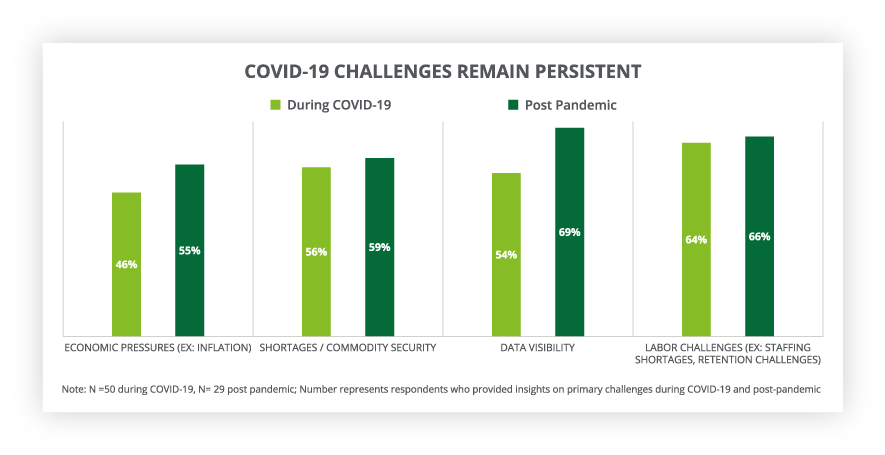Health Care Supply Chains Still in Survival Mode has been saved

Perspectives
Health Care Supply Chains Still in Survival Mode
Economic pressures, shortages, data visibility and labor issues remain primary challenges post-pandemic.

Three years after COVID-19 was declared a public health emergency, many health care organizations across the United States continue to struggle with demand for everything from contrast dye to surgical supplies, according to new industry research from Deloitte Consulting LLP.1
Despite earlier expectations that operations would stabilize as organizations enter the post-pandemic phase, these new findings indicate supply chain leaders and frontline professionals are still operating in survival mode. Ongoing challenges include economic pressures, multiple resource shortages, data visibility and labor issues.
Deloitte’s earlier research on supply chain resilience in 20212 revealed vulnerabilities exposed during COVID-19 and highlighted the need for health care supply chains to prepare for the next crisis, be that a catastrophic natural disaster or another pandemic.
To gain greater insight into these impacts, Deloitte expanded its study by conducting site visits to health care facilities, interviewing frontline professionals and re-interviewing supply chain leaders in private and public sectors across government, health care, academic institutions, and humanitarian non-governmental organizations (NGOs) from November 2022 to March 2023.
Notably, data visibility has become a more pressing concern, cited by nearly 70% of interviewees, a 15 percentage-point increase from the height of COVID-19 in 2021. Data visibility is crucial to, among other things, understanding, identifying and mitigating supplier risks.
Although creating a resilient supply chain is also critical, 73% of those interviewed indicated that the new expectation of constant disruption impacts their ability to focus on strategic initiatives, such as health equity.
Examples of Critical Supply Chain Disruptions to Health Care Since Declaration of COVID-19 Public Health Emergency
- Semiconductor shortage – January 2020 – ongoing
- Factory shutdowns and labor shortages – January 2020 - ongoing
- Aluminum shortage – July 2020 – ongoing
- Texas deep freeze – February 2021
- Suez Canal blockage – March 2021
- Plastics shortage – March 2021 - ongoing
- Hurricane Ida – August 2021
- American port congestion – October 2021 – January 2023
- Russia invades Ukraine – February 2022 – ongoing
- Helium shortage – October 2022 - present
Supply chain leaders are concerned about future crises due to the increased likelihood, frequency and impact of global supply chain disruptions, such complex geopolitical threats, natural disasters, and changing demand.3
However, there is optimism as nearly 60% of post-pandemic interviewees believe that supply chain will remain a focus for their organizations, a 13 percentage-point increase from the height of the COVID-19 pandemic. This more hopeful outlook is driven by a new consensus that robust supply chain resilience is needed to effectively respond to and recover from inevitable disruptions.
Recommendations for health care leaders
To increase supply chain resilience and enable health care organizations to focus more on implementing long-term strategic initiatives, Deloitte suggests that health care organizations consider:
Developing a robust risk management framework and continuously monitoring supply networks to prepare for possible disruptions.
Leaders need capabilities to conduct multi-tiered supplier analyses to increase visibility beyond direct suppliers. This will help them identify, anticipate, and mitigate vulnerabilities before they become pervasive challenges. Proactive risk management also enables organizations to forecast trends and patterns, drive informed investments, make effective operational changes, and efficiently alter sourcing strategies to increase supply chain resilience.
Focusing first on supplier relationship management for critical products.
Organizations should develop a supplier relationship management and risk mitigation strategy for products that are critical to patient care. Organizations should then evaluate their product portfolios to identify which products need supplier diversification and which products require active supplier relationship management. This will help establish strong lines of communication and better supply continuity plans, decrease costs, and increase flexibility and transparency, which ultimately improves resilience.
Leveraging a Human-Centered Design approach to identify opportunities for improvement.
People are a key driver of supply chain resilience, which makes employee and leadership buy-in critical to move beyond survival mode. Organizations should consider using design-thinking frameworks and methodologies such as Human-Centered Design to identify stakeholder pain points and develop action plans to improve the employee and patient experience. Human-Centered Design is an iterative process that considers the needs of internal and external stakeholders before developing solutions. By understanding the root causes, needs and motivations causing challenges, organizations can generate more dynamic, targeted solutions to deliver the best experience possible. Deploying a Human-Centered Design approach ultimately increases employee retention and strengthens employee buy-in to process and technology changes.
This publication contains general information and predictions only and Deloitte is not, by means of this publication, rendering accounting, business, financial, investment, legal, tax, or other professional advice or services. This publication is not a substitute for such professional advice or services, nor should it be used as a basis for any decision or action that may affect your business. Before making any decision or taking any action that may affect your business, you should consult a qualified professional adviser. Deloitte shall not be responsible for any loss sustained by any person who relies on this publication. About Deloitte Deloitte refers to one or more of Deloitte Touche Tohmatsu Limited, a UK private company limited by guarantee (“DTTL”), its network of member firms, and their related entities. DTTL and each of its member firms are legally separate and independent entities. DTTL (also referred to as “Deloitte Global”) does not provide services to clients. In the United States, Deloitte refers to one or more of the US member firms of DTTL, their related entities that operate using the “Deloitte” name in the United States and their respective affiliates. Certain services may not be available to attest clients under the rules and regulations of public accounting. Please see www.deloitte.com/about to learn more about our global network of member firms.
Copyright © 2023 Deloitte Development LLC. All rights reserved
Endnotes:
1 Interviews conducted of supply chain professionals from November 2022 to March 2023
2 Wendy Gerhardt, Tom Coleman, Jessica Franck, Paul Kreder, Jeff Petry, Key determinants for resilient health care supply chains, Deloitte Insights, April 22, 2022
3 Deloitte Global Risk Advisory, Toward True Organizational Resilience: Deloitte's Global Resilience Report, October 2022
Get in touch
 |
Tom Coleman |
 |
Jessica Franck |
